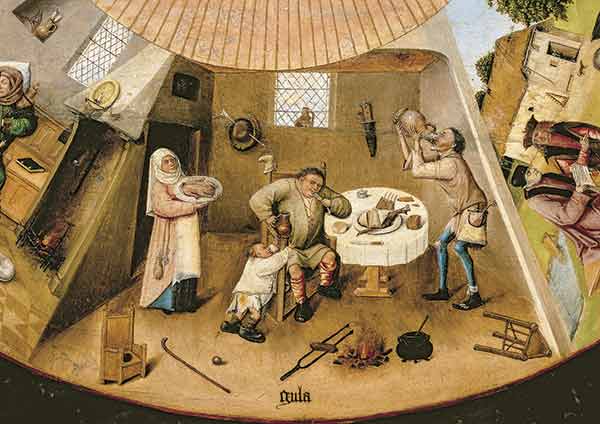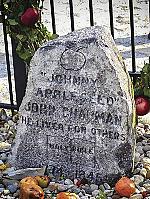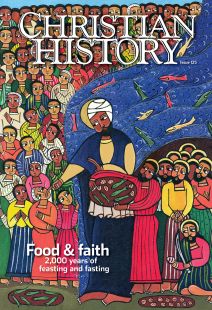Christian History Timeline: Feasting and Fasting
 a feasting timeline
a feasting timeline
— 30s Christians begin celebrating the first day of the week with prayer and a meal in honor of Christ’s Resurrection.
— c. 53 Paul’s first letter to the Corinthians contains the first canonical reference to the Last Supper and agape meals (1 Cor. 11:17–34).
— c. 100s The Didache and Justin Martyr’s First Apology contain some of our earliest extrabiblical descriptions of Communion practices; a homily attributed to Melito of Sardis is one of our first known references to the celebration of Easter, or Pascha.
— 325 Council of Nicaea sets rules for determining the date of Easter.
— 336 A celebration of Christmas on December 25 is first recorded in Rome; it is introduced into Constantinople around 378.
— 340 Synod of Gangra condemns Manichean practices including the requiring of vegetarianism.
— c. 360s Western Christians adopt the celebration of Epiphany on January 6 from Eastern Christians.
— 386 John Chrysostom preaches the earliest known sermon for the Feast of Christmas.
— 398 Fourth Council of Carthage rejects the practice of fasting on the Lord’s Day. — c. 550 Benedict writes his Rule for monks, which among other things urges them to receive guests as though they were receiving Christ.
— 567 Second Council of Tours forbids fasting between Christmas and Epiphany.
— 1000 Shrovetide is first referred to in Theodolphus’s Ecclesiastical Institutes; it becomes known as a period of feasting and carnival on the Tuesday before Lent.
— 1522 Christoph Froschauer and Huldrych Zwingli eat sausages on a Friday during Lent in Zurich, helping spark the Protestant Reformation there.
— 1700s Pietists such as the Moravians and Brethren reintroduce the custom of agape meals, calling them love feasts.
— 1737 John Wesley attends his first Moravian love feast; these meals will later become a central feature of early Methodist practice.
— 1942 Clarence Jordan founds Koinonia Farms, an intentional Christian farming community.
— 1965 Catholic Church publishes a rite for receiving both bread and wine at Communion as part of the reforms of Vatican II.
— 1967 Robert Farrar Capon blends spirituality and culinary delight in The Supper of the Lamb.
— 1969 Wendell Berry publishes his first set of essays on food and the environment.
a fasting timeline
— c. 40s Apostles reject Jewish dietary restrictions, but remain concerned about eating meat sacrificed to idols (Acts 15:29, I Cor. 8).
— c. 207 First references to fasting before receiving Communion and to Wednesday and Friday fasting appear in the writings of Tertullian.
— 325 Council of Nicea includes first reference to the Lenten fast as being 40 days long.
— 364 Council of Laodicea forbids celebrating agape meals in church.
— 511 First Council of Orléans sets Lent definitively at 40 days.
— c. 550 Benedict’s Rule forbids healthy monks from consuming meat other than fish or fowl.
— c. 750 Gelasian Sacramentary contains first mention of Ash Wednesday.
— 1050 Council of Coyanza commands Friday fasting year-round.
— 1562 Council of Trent codifies long-standing Catholic practice of offering only bread to the laity at Communion.
— 1809 William Cowherd founds the Bible Christian Church in England, a vegetarian church.
— 1829 Presbyterian pastor Sylvester Graham begins preaching the “Graham diet,” a vegetarian whole-foods diet.
— 1869 T. B. Welch discovers a way to pasteurize grape juice, enabling alcohol-free Communion.
— 1874 Female temperance advocates found Woman’s Christian Temperance Union.
— 1863 Ellen G. White and other leaders form the Seventh-day Adventist Church, which practices various dietary restrictions.
— 1878 John Harvey Kellogg invents cornflakes to serve as part of a wholesome Christian diet.
— 1917 Catholic canon law relaxes requirements on pre-Eucharistic fasting for the sick.
— 1920 United States adopts national Prohibition, repealing it in 1933.
— 1957 Charles Shedd publishes Pray Your Weight Away.
— 1966 Pope Paul VI permits Catholic jurisdictions to exempt believers from Friday fasting requirements.
— 1976 Mennonite Central Committee publishes More-with-Less cookbook.
By Jennifer Woodruff Tait
[Christian History originally published this article in Christian History Issue #125 in 2018]
Next articles
Everyday substances, heavenly gifts
From the beginning, the holiest Christian meal used everyday food
Andrew McGowanEating (and not eating) with the church fathers
Things church fathers said about food
Jennifer Woodruff Tait, compilerRaise a juice box to the temperance movement
Getting unfermented wine from the vineyard
Jennifer Woodruff TaitSupport us
Christian History Institute (CHI) is a non-profit Pennsylvania corporation founded in 1982. Your donations support the continuation of this ministry
Donate






